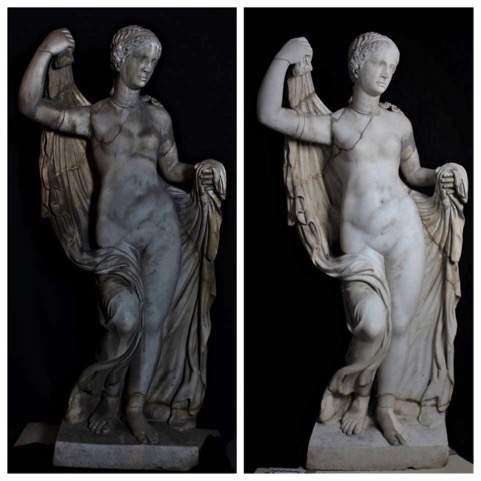On Tuesday, September 11, 2018, at 7 p.m., the recently restored marble statue from the classical period (dating back to the first century A.D.), thought to depict the mythological Leda, the princess of Aetolia who was united with Zeus transformed into a swan, will be presented to the public at the National Archaeological Museum in Florence as part of the special evening opening dedicated to "Masterpieces of MAF." restoration revealed instead that the statue depicts the goddess of love, Aphrodite.
The National Archaeological Museum in Florence carried out the restoration work thanks to financial support from the nonprofit Friends of Florence Foundation with a donation from Michael and Sandy Collins and conducted live inside the museum. Simonetta Brandolini d’Adda, president of Friends of Florence, said, “It is with great pleasure that we present the restoration of the ’rediscovered’ Aphrodite. The intervention, which made it possible to recover the work and was the occasion for an in-depth study of the sculpture. The restoration project of the work initially identified as Leda was presented at the first edition of the Friends of Florence Prize at the Art and Restoration Fair in 2012: having found donors willing to support it fills us with satisfaction. It is precisely on memory and beauty that the future of our civilization is at stake. For this we thank all those who made this project possible, starting with donors Michael and Sandy Collins, thanks to whom we were able to return another piece of Western history to the international community.”
The sculpture was recognized as a good-quality, Roman-era copy of a Greek original from the Hellenistic period, dating from around 300 BCE. The composition of the marble (from the island of Paros) in which the body is made is different from that of the head, and revealed that the latter, although ancient, is not pertinent, as are the arms and legs, which are of probably 17th- or 18th-century restoration: a practice, that of integrating lacunose finds by adding both ancient and specially created parts, which was intended to restore integrity (and beauty, in the spirit of the time) to them. Prior to the restoration work, supervised by Daniela Manna with the help of various collaborators, a complete photographic documentation of the sculpture and a series of diagnostic investigations aimed at recognizing any original polychromy, which emerged in traces in the drapery and hair (red ochre and gilding), were carried out.
After analyzing the state of preservation, identifying the relevant forms of alteration and degradation, different intervention methods were selected to selectively address cleaning, partial removal of previous restoration work, consolidation, and repair of gaps. The cleaning intervention was carried out using laser equipment for the gradual removal of black crusts. During the last stages of restoration, an original fragment was glued on using the same methodology and materials used in ancient times, which are still valid and consistent with the current display in the museum environment.
The interventions brought out the whiteness of the marble in which the work was carved, which had been obscured by the gray of dust accumulated over the centuries. The “rediscovered” Aphrodite, placed on a carved wooden base dating back to the early 19th century, will remain on display there where it was restored and studied, within the ground-floor itinerary, visible to anyone entering or leaving the National Archaeological Museum of Florence.
 |
| Florence, at the National Archaeological Museum the rediscovered Aphrodite: restoration completed |
Warning: the translation into English of the original Italian article was created using automatic tools. We undertake to review all articles, but we do not guarantee the total absence of inaccuracies in the translation due to the program. You can find the original by clicking on the ITA button. If you find any mistake,please contact us.